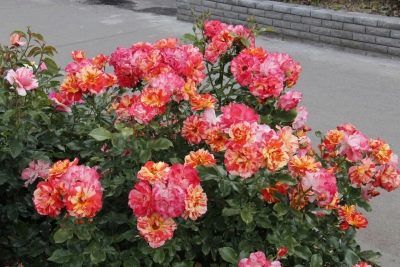
- Name synonyms: Alfred Sisley, Alfred Sisley
- Group: scrub
- The main color of the flower: yellow
- Flower shape: cupped
- Diameter, cm: 8-10
- Flower type by number of petals: thick double
- Scent: specific, with hints of apple
- Description of the bush: with erect shoots, rather dense
- Bush height, cm: 80-90
- Leaf size: medium
The exquisite variegated rose Alfred Sisley, named after the famous impressionist painter, is the dream of many gardeners. The variety forms a beautiful lush scrub with an easily formed crown. Also found in catalogs under the name Alfred Sisley, Alfred Sisley.
Breeding history of the variety
Rose of French selection. Received by Delbard kennel, cultivated since 2004. Included in the collection "Great Artists", along with other roses of this originator.
Description of the variety
The bushes of this rose have erect shoots, rather thick and lush, 80-90 cm high. The shape is almost spherical. Leaves are medium in size, dark green in color.
The flowers are cup-shaped, the buds are rounded, pointed to the edges. The main color of the petals is yellow. The buds are dark orange with contrasting pink strokes and stripes. The bicolor rose remains even when the corolla is fully opened. The color of the petals becomes dark orange, with stripes and shading of pink-cream color, golden center and yellow underside.
The diameter of an open flower reaches 8-10 cm. The corolla is densely doubled and consists of 26-40 petals. The buds are connected in inflorescences. There are 5-10 of them on the stem. The aroma of the flowers of this variety is weak, specific, with noticeable apple notes.
Advantages and disadvantages
Polyanthus rose Alfred Sisley managed to get high marks from gardeners in many countries of the world, twice won medals at exhibitions. Its obvious advantages include:
heat resistance;
preservation of decorativeness of petals during rain;
abundant flowering;
spectacular color of petals with pronounced variegation;
re-flowering.
Some disadvantages of the variety include poor suitability for cutting. And also roses Alfred Sisley do not differ in a high growth rate, they slowly gain height of stems.
Flowering features
Rose Alfred Sisley belongs to continuous flowering varieties. Forms buds very abundantly. The duration of flowering is from June to October.
Use in landscape design
This variety looks good in single plantings. Due to the unusual color of the petals and lush greenery, it can become a bright accent in the landscape. It is also used as part of mixborders. Combines effectively in a rose garden with other flowers of the same group.
Landing
Plants are planted in a very short period of time, from late April to early May. A partial shade or sunny side of the site without the scorching sun will do. The soil for this variety of roses is suitable for neutral or moderately acidic, rich in organic matter, nutritious and moist.
Growing and care
The plant is responsive to care. Requires frequent thinning and loosening of the soil. It is useful to mulch the soil, especially in arid regions. The bush slowly grows in height, but in the fall it can throw out long whips, in the first years it needs protection from frost, watering regulation. It should be fed according to the recommended schedule for this crop.
Pruning
In the spring, from roses of this variety, all whips damaged by frost are removed, and the tops of the shoots are shortened. In the summer months, wilted inflorescences are cut. Autumn is a time for careful thinning.If the bush shows signs of disease, all damaged parts are cut out at the root.
Frost resistance and preparation for winter
The variety is cold-resistant, withstands short-term frosts. With long-term preservation of atmospheric temperatures below the level of -7 degrees, it needs shelter.
Diseases and pests
Rose Alfred Sisley has a high resistance to major diseases. She hardly gets sick
Review overview
For a long time it was believed that the roses of the Delbard nursery are not very suitable for growing in Russia. But reviews from owners who already have experience in cultivating the Alfred Sisley variety prove that it adapts perfectly to local climatic conditions. This rose is rated as a plant with excellent health that does not require frequent watering. According to gardeners, the bushes rarely grow above 70 cm, while they are covered with lush clusters of inflorescences so abundantly that the foliage is not visible.
Cons are also found. Alfred Sisley disappoints gardeners with a rather weak aroma persistence. Terry is also not very pronounced. But the petals are curved along the edges with elegant flounces.































































